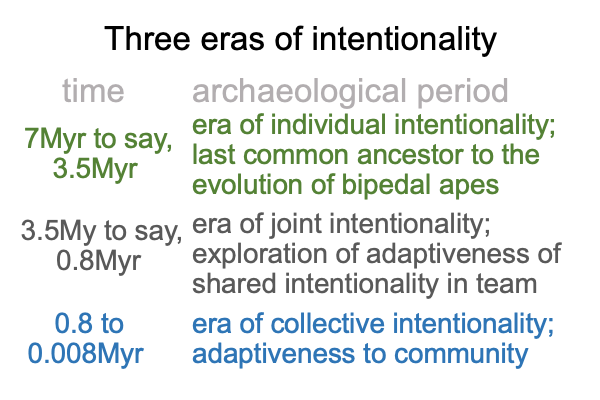0401 Have Tomasello’s previous books laid the groundwork for an exploration into the natural history of human… or is it?… hominin morality?
So, remember to cross out the word, “human”, and write the word, “hominin”, where “hominin” is technically defined as a human ancestor.
0401 Recall, the natural history of human morality occurs in generations prior to the appearance of anatomically modern humans. In previous works, Tomasello identifies three eras of intentionality.
Here is a picture.

0402 The era of individual intentionality shows interdependence with respect to family (5) and intimate friends (5). The band (50) is not interdependent in the same sense of the word. The band (50) is large enough to deter predators.
0403 The era of joint intentionality begins once bipedal “southern apes” collaborate in order to forage. The advance is so productive that collaborative foraging becomes obligatory. Obligatory collaborative foraging is conducted in teams (15). Teams have more members than family (5) or friends (5) but less than the band (50).
0404 Teams cultivate the capacity for joint attention2a. If joint attention2a is behavioral, then joint or shared intentionality2a is the corresponding cognitive capacity. This cognitive capacity is what cognitive psychologists observe in newborns and infants in their experiments in human ontogeny1c. This cognitive capacity2a embodies sociogenesis1a, where sociogenesis is more subtle than the mere naming of social circles. Sociogenesis1a is the potential of um… an actuality independent of the adapting species.
0405 Cooperation1b requires participants in joint-attention activities2a to serve different roles while sharing the team’s shared intention2a… that is… purpose2a.
Is there a problem?
Free riders must be excluded.
Well, the solution turns out to be remarkably simple. If an individual does not pull weight, for whatever reason, then the team meets without the slackard. How simple is that?
Or, should I say, “How awkward is that, especially when the excluded individual discovers the secret that everyone else knows?”
Ah, members of a team respect one another. They do not respect the grifter.
0406 Tomasello never says that morality is pretty.
Those who only appear to share the team’s purpose are dangerous to others, as well as themselves. They lower the reproductive success of all concerned. They are killjoys. Each member of the team should move according to the team’s purpose. Such movements are fair and good. Yet, hand-talk words for “fair” and “good” do not exist. What is there to picture or point to? When do hominins figure out that they can smile or grimace, in order display approval or disapproval?
Yes, team activities are all about “me” and “you”.
Tomasello calls the natural, embodied, team-based morality of the era of joint intentionality, “second-person morality”.
0407 In the era of collective intentionality, hominin interdependence2b cultivates sociogenesis1a in band (50), community (150), mega-band (500) and tribe (1500). Today, these correspond to neighborhood (50), church (150), farmer’s market and festival (450) and diocese (1500). These larger social circles come into play because the domestication of fireincreases the number and diversity of teams.
The morality that characterizes teams infiltrates smaller social circles as well as larger. Collective intentionality is no longer motivated by the slogan, “We work for food.” Collective intentionality says, “We work for organizational objectives, that are based in righteousness and goodness.” But, hand-talk cannot gesture the words, “organizational objectives”, “based”, “righteousness” and “goodness”. These spoken terms are explicit abstractions. Hand-talk facilitates implicit abstractions, characteristic of the exemplar sign.
0409 So what is a hominin, in the era of collective intentionality, to hand talk?
Can the hominin gesture, “The morality that characterizes the community and the tribe extends to the living, the dead and those who are yet to be born.”?
What fully linguistic gesture-words suffice?
Can the hominin gesture, “We belong to the one who gives, without us knowing why?”
[POINT to self][SWEEPING POINT to others][CAST EYES to SKY][CRADLE ARMS Then LOOK AT CRADLED ARMS as if receiving something from SKY][LOOK back up at SKY][SHRUG]
0410 Those who accept their gifts, their missions, their community roles, the mantle of tradition, their responsibilities and yes, their fates, are blessed with reproductive success.
But, enter the modern, who asks, “Does this associate to the term, ‘conformity’?”
How far have we fallen?
0411 Tomasello envisions a kind of cultural and group-minded “objective” morality.
The term, “objective”, is modern. It means “independent of anyone’s particular judgment”. The premodern Latin schoolmen use the term, “suprasubjective”, which means, “simultaneously encompassing and transcending our subjectivities”.
Here, in Tomasello’s selections of terms, this reader spies a bias towards the scientific. Scientific facts and theories are “objective”.
This modern term fails to capture what collective intentionality expects of us. “Objective” morality is independent of anyone’s point of view. “Suprasubjective” morality interpellates us to align our judgments, our species intelligibili, with the truth, the foundation of all human institutions that promote human flourishing.
Yet, as noted above, there is no hand-talk gesture-word for “truth”.
What is there to image or indicate?
0412 What does this imply?
Truth is built into the hominin brain and body. We are on the lookout for signs of truth. Truth is the foundation of the righteous and the good. We know this in our heart and bones. We ourselves are gifts of the one who gives, without us knowing why.
We, the living, and we, the dead, and we, the ones to come, constitute the tree of life.
[POINT to breath][PANTOMIME tree]
